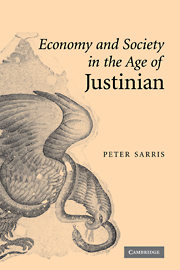Book contents
- Frontmatter
- Contents
- List of figures
- Preface
- Introduction
- 1 Egypt and the political economy of empire
- 2 The Apion archive: economic structure and estate accounts
- 3 Labour and administration: the evidence of the contractual papyri
- 4 Letters and petitions: social relations in the sixth-century Oxyrhynchite
- 5 The Apiones and their analogues
- 6 On the margins of magnate power: Dioscorus and Aphrodito
- 7 Landscapes of power: the great estate beyond Egypt
- 8 The historiography of the great estate
- 9 The great estate and the imperial authorities
- 10 The rise of the great estate
- 11 Economy and society in the age of Justinian
- Conclusion
- Bibliography
- Index
6 - On the margins of magnate power: Dioscorus and Aphrodito
Published online by Cambridge University Press: 24 July 2009
- Frontmatter
- Contents
- List of figures
- Preface
- Introduction
- 1 Egypt and the political economy of empire
- 2 The Apion archive: economic structure and estate accounts
- 3 Labour and administration: the evidence of the contractual papyri
- 4 Letters and petitions: social relations in the sixth-century Oxyrhynchite
- 5 The Apiones and their analogues
- 6 On the margins of magnate power: Dioscorus and Aphrodito
- 7 Landscapes of power: the great estate beyond Egypt
- 8 The historiography of the great estate
- 9 The great estate and the imperial authorities
- 10 The rise of the great estate
- 11 Economy and society in the age of Justinian
- Conclusion
- Bibliography
- Index
Summary
INTRODUCTION – THE APHRODITO PAPYRI
Before turning to the evidence for the empire as a whole, the picture derived from the Apion papyri and other documents of an essentially ‘aristocratic’ focus requires a measure of nuance. At a local level, families such as the Apiones clearly wielded an enormous amount of influence and power in late antique Egypt. Yet, as the epistolary papyri inform us, even on the Apion family's own estates, the authority of the landowner and his representatives did not go entirely unchallenged. The power of the great landowner was always contestable, and there were always those willing to contest it. The papyri record that amongst those who sought to do so in the sixth century was a practising lawyer and jobbing poet from the Middle Egyptian village of Aphrodito known by the name of Dioscorus.
Two thematically and chronologically distinct papyrological dossiers survive from late antique Aphrodito. The later of these, dating from the Umayyad period, is derived from the bureau of a local Arab governor, Qurra b. Sharik (r. 709–14). For the earlier period, encompassing much of the sixth century, the extant papyrological dossier preserves part of the archive of one of Aphrodito's most prominent families, the descendants of a certain Psimanobet – ‘the goose-herd's son’. Although, as this name would suggest, the origins of the family were relatively humble, by the early sixth century, as two commentators on the Aphrodito papyri have noted, its male members had come to serve
as leaders of their community in successive generations … Because they were respected for theirwealth and literacy … they often signed documents for illiterates who could not do it themselves. […]
- Type
- Chapter
- Information
- Economy and Society in the Age of Justinian , pp. 96 - 114Publisher: Cambridge University PressPrint publication year: 2006

